#nz hetalia
Explore tagged Tumblr posts
Text

Whoever these idiots are am i right
🦘🇦🇺🇳🇿🥝
#aph new zealand#aph australia#hws new zealand#hws australia#hetalia#aph ocs#kinda ocs not rlly tho just my designs of existing characterz#ooc#muns art#watch this become an aph nz fan art account only
7 notes
·
View notes
Text
Piggy backing off my last post, if much like in 2016 you're going "I should just move to New Zealand" head my warning, little yanky
People are not going to like you. People will hear the accent and either think you're a Trump supporter or a stereotypical stoner valley dude with half a brain cell.
Learn a bit of Te Reo Maori. You don't have to learn a lot, just your basic greetings, but you should learn place names and pronunciation
There was a huge cover-up in 1948 when a group of American service men tried to stop Maori bar patrons from coming inside. Naturally, both white and Maori patrons beat the shit out of them. The fight involved hundreds of people. As far as we know, two people died in the Battle of Manners Street, both Americans. This was during an event called the American Invasion, where Aotearoa asked for British aid during the war and were sent Americans instead. Americans who were documented as mostly sitting around, being incredibly racist, and assaulting our wāhine. So maybe don't walk down Manners Street at night. It might be haunted, I dunno.
While you're looking at Te Reo, look a bit into Tapu and Noa. This is about things that are considered sacred, but it also just gives you good kiwi manners, like taking your shoes off when you go into someone's house and not sitting on tables.
Learn how to tō waha - shut up. All I hear from the Americans I've met living in Aotearoa is that the second they go home, they realise how loud Americans are. Take a deep breath, listen to nature, and lower your voice
Did you know ANZUS is no longer a mutual agreement of power because America got upset that Aotearoa is nuclear free and so didn't allow any US naval ships into port after 1984 because they had a policy of not confirming or denying if they have nuclear weapons on board? They're still kinda holding a grudge against us for it and disolved a whole allyship over it! All that to say, in 1987, we formalised our anti-nuclear stance, so whether travelling by air or by ocean, please keep all your W.M.Ds at home! (Bill Clinton reinstated our allyship in 1996 and gave us the status of "Major non-NATO ally" but that's the year my sister was born so I don't acknowledge it)
It's crazy that America is so anti-terrorism but when the French sunk the Rainbow Warrior in July 1985 and everyone, including their 'besties' Australia were like "yo bro the French just did a terrorism on New Zealand...that's like not cool right?" America refused to acknowledge it. Only in September, after France admitted guilt did America go "we hate terrorism grr" I don't know what my warning here is I kinda just remembered and went "huh." Don't do terrorism, but if you do it's okay because America will be chill with it?
While the two older halves of the ANZUS polycule were sending military forces into the Vietnam war, New Zealand just sent economic aid and medical aid. We're lovers, not fighters (#FreePalestine). We did, uhm... supply Agent Orange... but that was after America was like, "We'll kick you out of the polycule again," and that's just so much work. Peer pressure works on us. We're people pleasers.
There you go! Those are all my tips for relocating to the Better DownUnder! I could go on, but my therapist said I should avoid thinking about Bill Clinton and the Big Bad War on Terror if I want to make it to 30 ^_^ I hope this was helpful!!
#us politics#us election#election year#election 2024#america#american politics#american history#history#politics#new zealand#nz history#nz politics#aotearoa#land of the long white cloud baby#do not come here#i like my farms and my forests#if another one gets cut down for housing#i will murder#sorry tags#vietnam war#wwii#fucking uhh#terroism#lol sorry#im eeeby#oh um can someone make a hetalia style fanart or fanfic about ANZUS?#nz being like australia no! you said i was your special little guy and now i see you with this older man! ah#ah!#but its like#about terrorism and war
8 notes
·
View notes
Text
Here's a fun(?) thing to do on a Wednesday evening - compare the US Embassy versus the Canadian High Commission to London.
The Canadian is this beautiful grand Neo-Grecian building directly on Trafalgar Square and is shining and beautiful and look at all those maple leaves...

Then the US meanwhile has been punted to south of the river (gasp! the only one south of the river ohoho aren't you special) and it... Well.

All hail the cube.
#anyway who's arthur's favourite you can argue either way but#...#i don't know necessarily if it's the one who got the cube#even if it did cost a butt ton#BANISHED!!!! to the south of the river#op#so many dominion related things in london are so grand and large and then the american stuff is like... modern nightmare#discounting nz's embassy here because WOOFT talk about a downgrade#oh 60s rebuilds how you haunt us all#oz has a nice one though and sa too - opposite canada's at trafalgar square#...obviously the dominions got the best places who am i kidding#everyone else like europe or asia just gets a house#i mean *fancy ginormous* houses#but still#canada oz and sa get 1920s mansions nz gets a 60s hotel and usa gets... isolation cube#hws england#hws america#hws canada#hetalia
27 notes
·
View notes
Note
WHAT DO YOU DO TO PASS TIME?

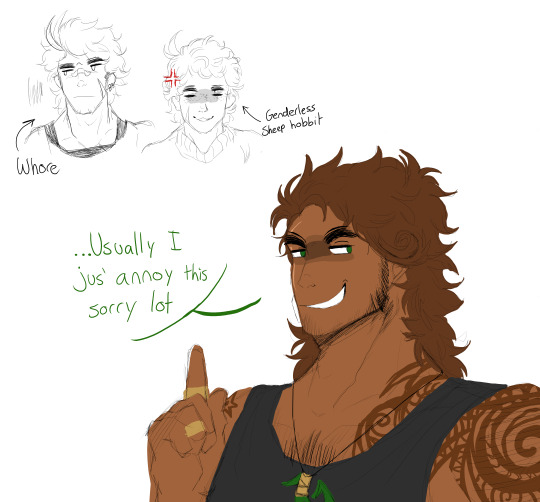
"...n' THAT, mate, is good fun."
@asktheoutbackhimbo // @ask-aph-tonga
#asknzmate#aph new zealand#aph#hws new zealand#aph australia#aph tonga#ask#new zealand#nz#aotearoa#hws australia#hws tonga#hetalia#axis powers hetalia#ask blog#hetalia ask blog#anon
17 notes
·
View notes
Text
hey what if i got back into hetalia. would that be mental or what
#by getting back into hetalia i naturally mean writing/absorbing aus and nz content only and occasionally writing a fic about#england dying of some horrible disease in the seventeenth century#listen ive spent the last year of my life doing an honours thesis on dysentery and by GOD im going to force people to know about it
4 notes
·
View notes
Text
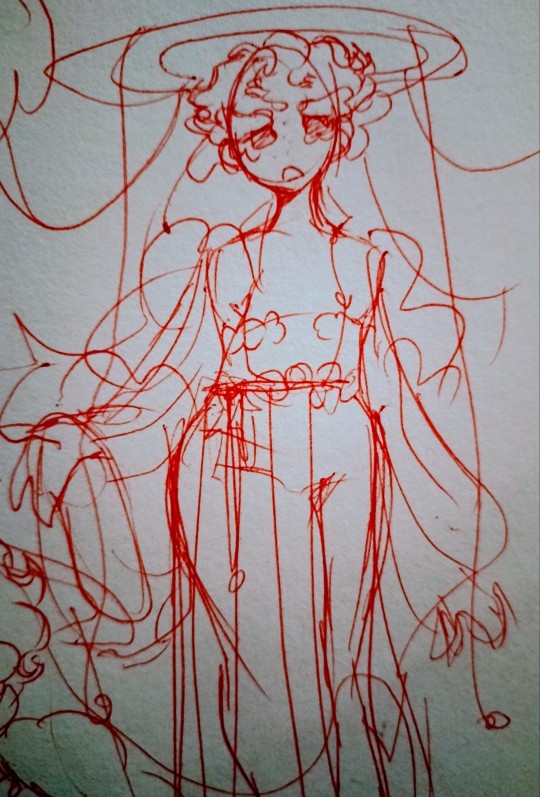
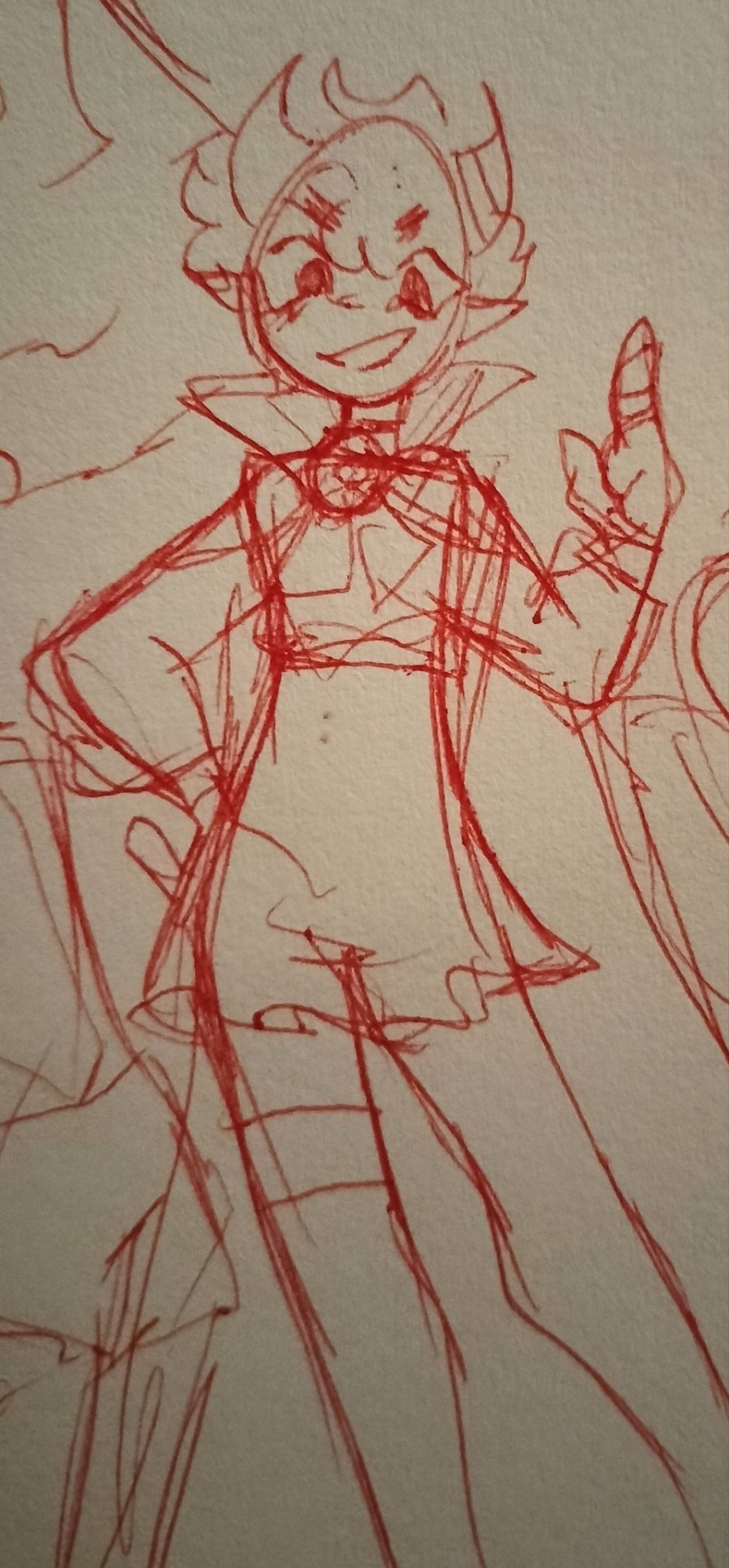

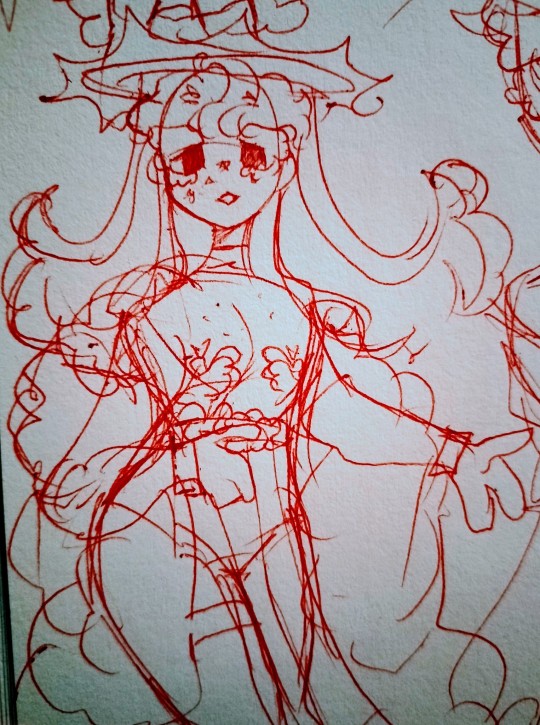
7 deadly sins au wip
#my art#hetalia#hws england#hws wales#I've had this au since like middle school but wales eas nevet in it#basically hes one of the seven heavenly principles along w nz nire ire scot and australia#but arthur turned into or was born a sin so he gets the sins together#originally kiku was envy ivan was greed italy was sloth germany wrath america gluttony and arthur pride#i missed someone#LUST#that was francis obviously#and yao jn the og au was sent to get rid of them so he tries to befriend them#its still the same in this au except wales is the one who sent him like 'bring my brother back'#and ofc its waleseng#idk if it jad alfred x arthur I'm probably gonna have him be gay w everyone#but im thinking Arthur x dylan (and yhe other brothers) as endgame#idk we'll see#7deadlysins!au
11 notes
·
View notes
Text
So do we as a fandom have a design for 2p Australia or is it a "make whatever the hell you think fits" kinda deal?
#I've become increasingly more obsessed with Australia and i need more fandom content#ive never seen 2p stuff for Aus or NZ#hetalia#hws hetalia#hetalia australia#aph hetalia#iggika post
8 notes
·
View notes
Note


"Go on take a tam ya bugga! Tim tam fer a Tim tam! Oim keepin th' name ya ol' arse."
Well if ya ask me Tim-Tam, if ya think it's too quiet I'll gladly come n' bug ya!!! - @asknzmate

Netherlands: "Hey, and don't call me Tim-Tam!"
@asknzmate
#I AM SO SORRY FOR THE LATE REPLY GOOD GOD#hope this makes up for it mate <//3#Also Tim tam is a name thats staying#aph new zealand#aph netherlands#reply#asknzmate#hws new zealand#hws netherlands#hetalia#aph#ask#new zealand#nz#aotearoa#ask blog#ask-thenetherlands
14 notes
·
View notes
Text
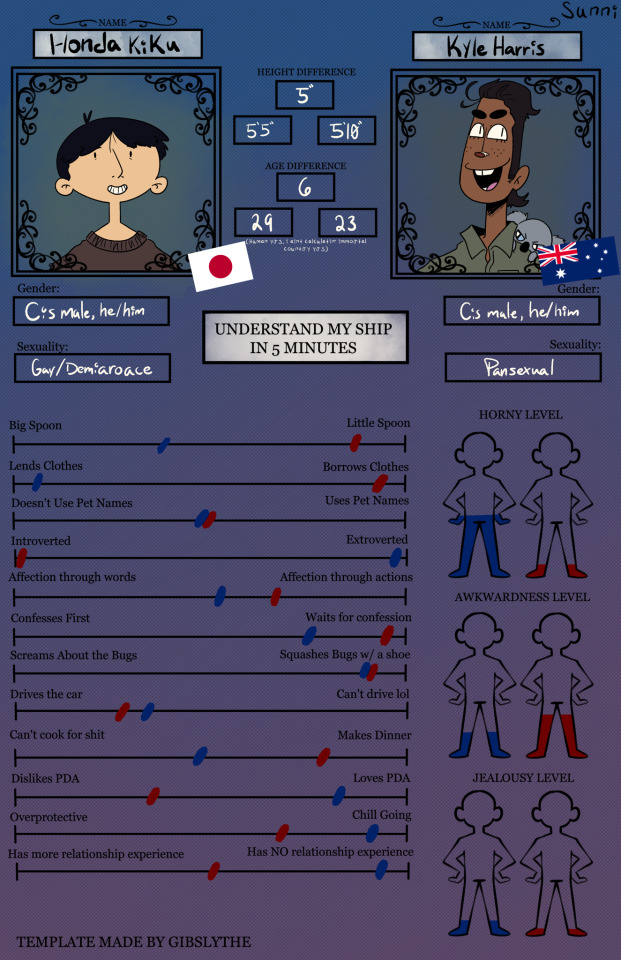
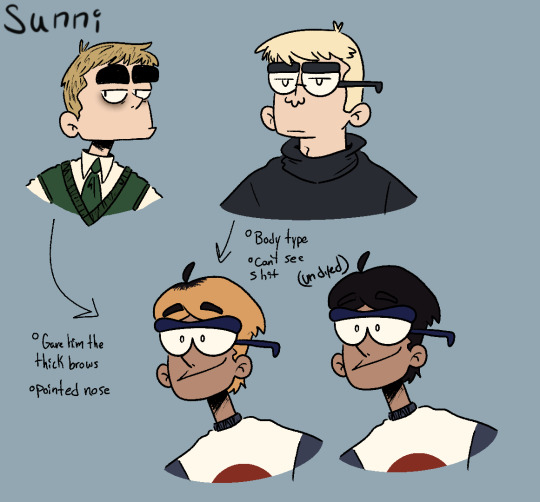
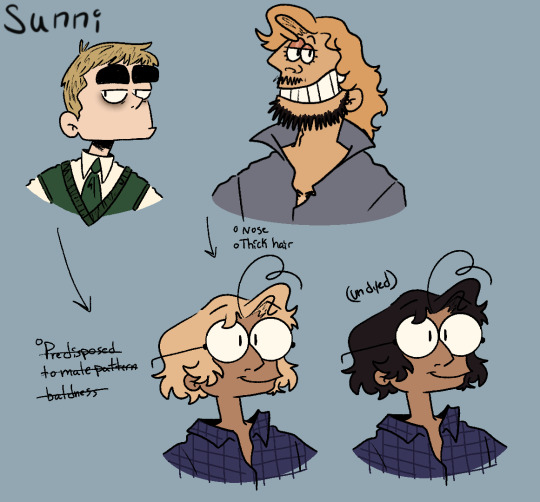
Miscellaneous bullshit ❤️
I couldn’t figure out just how i wanted to draw the NA brothers so i did some brainstorming and these are the end result! I decided to go with them being half indigenous— but they of course never did represent any tribe whatsoever. They were “born” shortly after their founding. They didnt get many traits by their colonizers/founders, just a select few. America is thankfully exempt from the male pattern baldness, thank you Sweden for the good genes 🙏 I just wanted to be self indulgent and make them indigenous tbh. I love any version of the bros that the fandom creates! And the same goes for Australia, NZ too once I design him. Hetalia is too white /j
#side note: NA bros never really got the chance to reconnect with their heritage bc they were pretty far gone#into england ‘training them to be civilized’#thats the hard truth im sorry yall#it happened to my ancestors thats the real history#so yes i am applying it to the characters#id advise warning tho if you ever look into this its hard to read…#hetalia#hetalia fanart#hws america#hws australia#hws japan#hws canada#hws england#hws sweden#aussiepan
29 notes
·
View notes
Text
The Identity of the Three Unnamed Micronations - A Hetalia Theory
So you all know these little guys from the 500th chapter in the World Stars manga, right?
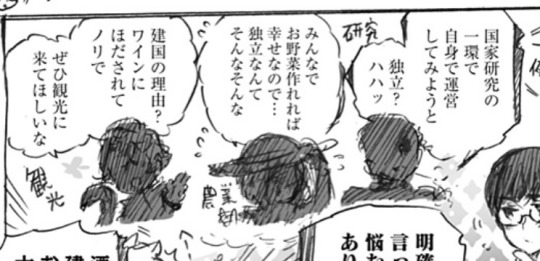
They were obviously teased as other micronations that we may or may not get an identity for, so I'm here to theorize which micronation they could be and why.
Firstly, to get a better idea of them, we have to look at their dialog. So we're off to run this thing through Google Translate!
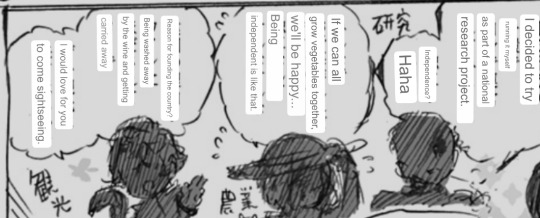
(Translation by @/gobernadoraph)
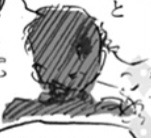
The one on the right is Australian, given the hair and the huffing out air thing that Australia and Wy do. But which one, I don't know. In Google Translate (I don't trust it though) seems to imply they don't care for independence and was some sort of national research project instead. This is the one I don't have any idea of on who they are, since all the Australian micronations I researched don't fit the bill on being a "research project".
My main running theory is that this is the Empire of Atlantium, but then again, that's a bit of a stretch since they seem to view themselves as a legitimate nation, and this one seems to scoff at the idea of independence. So this idea is highly unlikely. Who knows, maybe Himaruya found yet another obscure micronation to personify.

The middle one was theorized to be the Garden Republic of Sirland. Which I think fits, given the sun hat and simply wanting the plant vegetables. This theory was brought by @/gobernadoraph from the MochiDex server! Here's to hoping this is a cute girl in a sun hat and not a femboy twink..
The left one I have the clearest idea of who they can be, they're the Republic of Whangamōmona. Why do I think this? Well, look at the character's design.

The mouth looks reminiscent of New Zealand's. They hold a cane, just like New Zealand, the hair even looks similar to his! (To me, it looks like a mix of Ireland and NZ's hair, minus the ram horns) that flower thing next to them also frequently appears whenever NZ speaks in the manga!
Also, this may be a bit of a stretch, but their outfit is also similar to one of NZ's outfits in his concept sketches with the open jacket.
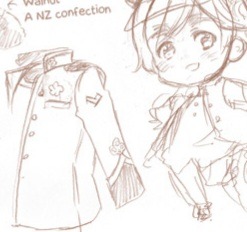
So this is the one I am the most certain on being which micronation is which, besides, it'd be a nice edition to Oceania since Hima hasn't given Tonga a canon face and it's been years..
BUT WAIT- I HAVE MORE!
What if these three were meant to parallel the main OG three micronations? (Wy, Sealand, and Seborga) like what if they're some kind of new generation version of them? (Probably not, but who knows. Maybe they are, in some way)
Now, let's explore that idea.
The guy on the right could be a parallel to Sealand since they don't seem to be concerned about independence and kind of laugh at it. Or thinks the idea is so ridiculous that they don't believe it. Unlike Sealand, who is very eager to prove he is a real nation.
The middle could be a parallel to Wy, who, unlike her, isn't sassy or headstrong. Instead, we get someone who is rather nervous and shy, judging from the sweat emote things.
The left one could parallel Seborga, but instead of flipping it around like the other two, they're just chill like him.
But until Hima actually introduces us to them (which is probably unlikely, if I'll be honest) and gives as canon identities and designs- these will just remain theories and speculation.
Anyways, goodbye, and thanks for reading this all the way through! And if you have any better ideas on who these lil guys can be, tell me in the replies or reblogs!
#hetalia#hetalia world stars#hetalia headcanons#hetalia micronations#hws#hws micronations#hws niko niko jr#hws japan#hws sealand#hws wy#hws seborga#svens talks#svens stuff
18 notes
·
View notes
Note
Hi I just spent so long scrolling through your blog, it's an absolute goldmine! I love the way you approach historical hetalia and delve into how these nations feel and interact. This is exactly what got me into hetalia almost decade ago and why I'm still stuck here. The way you characterize the fam is amazing, the dysfunctional relationship betwen Alfred and Arthur, Matt stepping in, etc. I'm rambling at this point but I can't tell you how amazing this blog is and happy I am to find it.
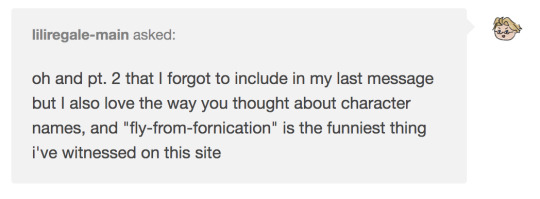
sorry for taking some time to answer this, but genuinely, thank you so much for sending this sweet message! comments like these are exactly why i've stayed in the fandom for so long. and yes, there's so much to explore with the family in hetalia; arthur and alfred are so interesting to think about, within this 'young ambitious crown prince / shrewd and cunning old king' dynamic, conflicting against those moments where there is some longing for a simpler father-son relationship. and lmao, i owe 'Fly-from-Fornication' to a post listing examples of historic Puritan names. something about its outlandishness to modern eyes, and contrast to how older Alfred depicts himself (charming, flirtatious hollywood showman) was very fun.
the other nice thing about being in the fandom for years is that i've had the chance to meet some really cool people, and imo, the best headcanons often come through that collaboration— bouncing ideas off and researching with friends. in this case, i owe a lot of thoughts about the father/son dynamic, alfred's relationship with matt, matt's characterisation (being his father's sword and first dominion, but who also deals with being overshadowed) — and the expanded concept of Jack (AUS) and Zee/Eleanor (NZ) as Alfred's two other siblings to my friend @historia-vitae-magistras (who created many of the original character concepts for Jack and Zee, particularly the latter, whom we've retconned quite a bit from canon).
it's been three years since i first drew that old US/CAN/AUS/NZ sheet about their rship with Arthur, and i do like that i'm not even close to done exploring that history. there is the warmth, alongside the struggles, complexities, ironies and other contradictions about identity and power that arise when kinship is forged out of the saltwater, steel and conflict of empire. irl, i also ended up writing my dissertation with a focus on british imperial history in the pacific context 😂. there is always more history to layer on, especially when i join it to my headcanons of Yao, Kiku, Yong-soo and the SEAsian characters (who I'm still coming up with names for haha). it's one of my favourite areas to explore because these themes of culturally and ethnically mixed identities and familial ties across national lines are very personal to my own family's history and experiences within the british empire. and generally, i love pulling from what i've learned about history and historiography to approach these characters, so i'm very happy my approach to hetalia speaks to you.
47 notes
·
View notes
Note



"Frankly oi'll 'ave yer know oit's pretty big drongo."
*distant aggressive sobbing*
About James, y’know muscular men have the smallest dicks right..? 🤨
"Now if ya say that to his face, he miiiight get a bit butthurt. So I'd beware. He comes 'round here often"
#asknzmate#aph new zealand#aph#hws new zealand#ask#new zealand#hws australia#aph australia#asktheoutbackhimbo#nz#aotearoa#hetalia#he is butthurt watch yo backs //ooc#anon
8 notes
·
View notes
Text
Historical Hetalia Week Day One: Heirlooms
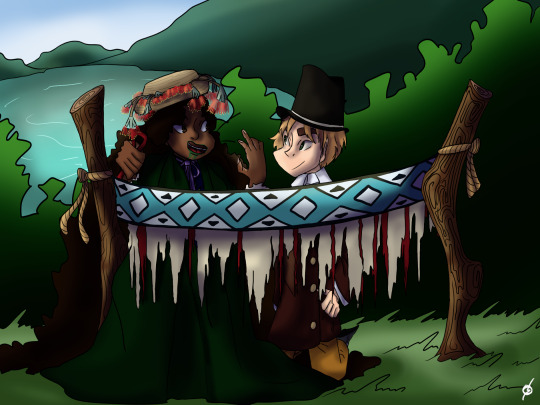
Day One: 10000 BCE - 5000 BCE // Heirlooms @historical-hetalia-week
(Unfortunately, I don't have much for such a long time ago!!)
The heirloom part may not be immediately clear...essentially I was wondering if culture (especially culture and traditions inherited by predecessor civilisations) might be 'heirlooms' to Nations. So, this piece is based on the sharing of cultures and 'creation' of heirlooms. Further explanation below the cut!
My main inspiration for this piece was the book 'Dressed: Fashionable History in Aotearoa [New Zealand] 1840 to 1910' by Claire Regnault. (A book I'd highly recommend, by the way, if you're curious about early colonial NZ history.) While it primarily focuses on the lives of the settlers, especially regarding their fashion, the earlier chapters provide fascinating insights into the interactions between the first settlers and the Māori people pre-dating them.
Pronunciations (there will be a few of these scattered where they are relevant):
Aotearoa- Ow-teh-ah-rowuh (like rower) [aɔˈtɛaɾɔa]
Māori- Mow-ree [ˈmaːɔɾi]
While there were, of course, a variety of reactions (ranging from incredibly racist to surprisingly sympathetic) on the European side, the predominant Māori reaction is what most drew my interest. Presumably because British settlers assumed themselves to be entirely superior to the natives of Aotearoa, they would look condescendingly onto the Māori people and their practices- but the Māori people largely did not hold the same view. As such, Māori who traded with the early Europeans were entirely willing to incorporate aspects of European culture and tradition into their own existing norms.
(**Fair warning for some quotes of racist thinking: Hilariously, to the modern eye, in one European attempt to 'civilise' the Māori women and to instil "moral and industrious Habits" (to quote the Reverend Samuel Marsden), Marianne Williams (née Coldham, 1793-1879) began to teach Māori women how to sew, dress themselves, and generally behave in the European way, horrified by their 'lack of womanliness'. Her sister-in-law would join her three years later. At the time, the Church Missionary Society, who were largely in charge of their endeavour, far preferred married couples to join them in 'educating' the natives, for they feared that single men were "likely to fall into the traps which are continually put in his road by native females". And while men were certainly not involved in the teaching of sewing to Māori women, Marianne and her sister-in-law were not without their own... struggles in this aspect. To quote Marianne: "The tall muscular forms of the Newzealanders flitted before my mind's eye whenever I endeavoured to sleep." I had to laugh when I read that. Oh, the irony. **)
**I'd like to quickly note who, exactly, I'm portraying in my piece. This will better contextualise my illustration. On the right is England (as might be obvious), though the left is a bit more complicated. I personally do not agree with the canon depiction of New Zealand in Hetalia (which, of course, is my own perspective, and I welcome other opinions as well), and so I've created my own oc NZ character. However, she is not in this image. In creating her I had to wonder about her origins- and where she stands considering the great racial divide in her country. My perspective is that, prior to European arrival, there was a representative of the Māori culture as opposed to individual iwi. The colony of New Zealand (and later the country) is both her younger sister and the younger sister of England, stuck in the middle. On the left in this image is the Māori representative (who likely goes by Aotearoa in modern time, at least as one among many names, but who at this point I can only see her calling herself Tangata Whenua)- there will be more explanation on her to convey why all of this is as it is in my mind.
Tangata whenua- Tah-nga-ta fen-oo-a [ˈtaŋata ˈfɛnʉ.a]
In particular (and as is depicted here) the Māori people became enamoured with blankets. This is likely because they could be wrapped around the shoulders and look remarkably like kākahu (picture below) cloaks, which were a way to show social status in Māori culture. Eventually, the Māori traders became so proficient at judging the quality of the blankets Europeans would trade to them, that they were far better judges than the European traders attempting to sell them.
Kākahu- kaah-ka-hoo (couldn't find an IPA for this)
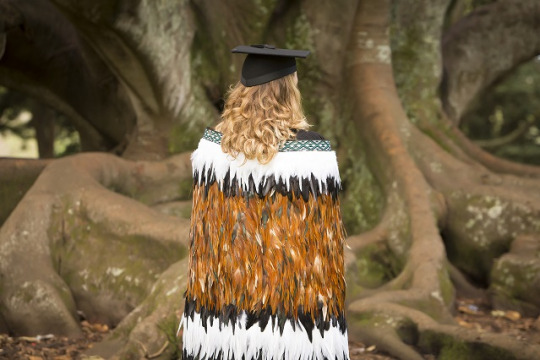
(Taken from Academic Dress Hire. Kākahu is the general word used to refer to Māori cloaks, though there are many individual types with their own names. This depicts one type.)
Another key point of interest is how Māori incorportated European sewing, etc techniques into their own garment creation. Red (whero- pronounced ferroh or ferraw) is a very important colour in Māori tradition, representing high status. Your historic Gucci watch, if you will. So Māori traders were likely ecstatic to see red wool among the many goods offered to them by European traders- both for its presumed price and abundance, and the prior context. This can be seen through kākahu cloaks produced following European contact, many of which incorporated red wool. Below are two examples (both taken from Dressed- apologies for any issues):

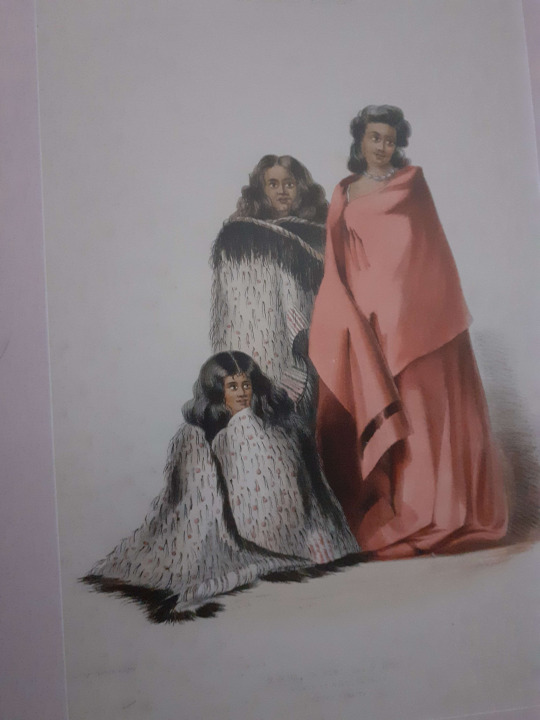
(Second image originally from George French Angus' book 'The New Zealanders Illustrated', published 1847)
This mixture of techniques is something I have attempted to depict in this illustration- however I am no expert in kākahu creation, and am not here to pretend that I didn't get something (or multiple things) quite wrong in that aspect. I'm no expert!
This illustration is set vaguely around the 1840s - 50s, though leaning more towards the early 40s. Arthur's outfit is mainly inspired by the following two illustrations from Panorama's 'A History of Fashion: From Loinclothes to Lycra' by Jacqueline Morely, David Salariya, etc, which date to 1828 and 1847 respectively, so take that how you will.
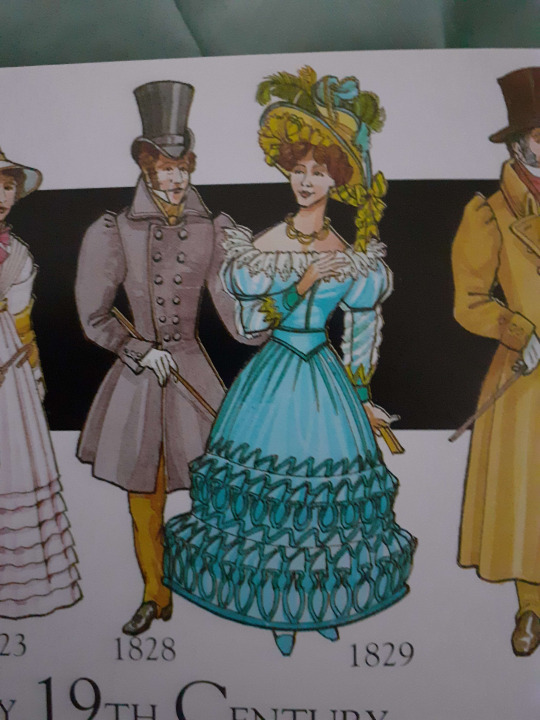
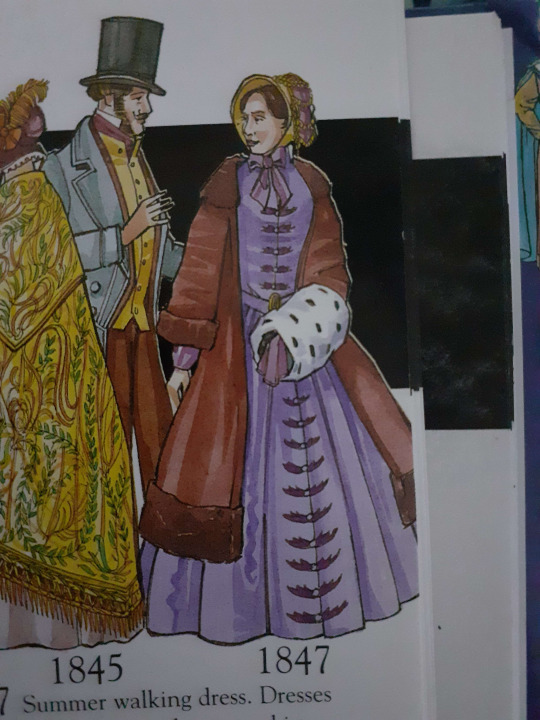
In the illustration, Tangata Whenua and England appear to be working together to construct this kākahu which combines both of their cultural practices into one garment. However, upon further observation, inequalities in this exchange of culture can be observed. For example, Tangata Whenua is entirely clothed in European garments. While she wears the blanket as a cloak substitute (making it a distinctly Māori appropriation), and undoubtedly hasn't bothered herself with the layering of undergarments, etc under her dress, and her hat depicts pohutukawa (paw-hoo-too-kawa) flowers as an added accessory, the point stands that she's made an effort. England, meanwhile, dresses himself in only the European style. Tangata Whenua is the one explaining the process to him and grasping the weaving. While he is curious, it is implied that he's done none of the work. This is meant to draw comparison to relations between Māori and Europeans at this time and onwards. The Māori held respect towards the European way of life, and tried to meet it on equal grounds. Europeans looked condescendingly down onto the Māori way of life, and, while initially intrigued, over time and with more concentrated governance, this would be forgotten, and te Ao (teh ow) Māori would be steamrolled over. For now, Māori remain friendly- but as the wrongs begin to add up, this will change.
(Let's just say New Zealand's early years will be spend embroiled in civil war.)
If you've just read this far for explanation of the post, you've reached your conclusion. From here, I'm gonna talk about my oc and the inspirations behind her :)
Tangata Whenua draws inspiration from two Māori women depicted in Dressed- one in personality, one just had a stunning hat. I've not quite figured out a human name for her yet, but I'm fond of the given name Māra (Maahra). However, Māori traditionally changed their names often, and so this is likely only one of the many names she is known by. Mara (without the ā- pronounced exactly as it looks) is both a term of address to someone close to you in the north, and a word meaning piece/scrap/rag. Māra can mean a garden/cultivation, and related to Māra Tautāne (toe-taahne)- a ceremonial garden where the plants grown within are offered to Rongo (rawngaw) (god of cultivated plants). I feel she got this name when someone (aware or unaware of her nature) addressed her by mara, and she realised its second meaning, as well as its connections to gardens (which I can see as a metaphor for societies, etc, and their growth/cultivation) and thought it quite fitting.
As for her hat, that is inspired by this painting, also by George Angas:
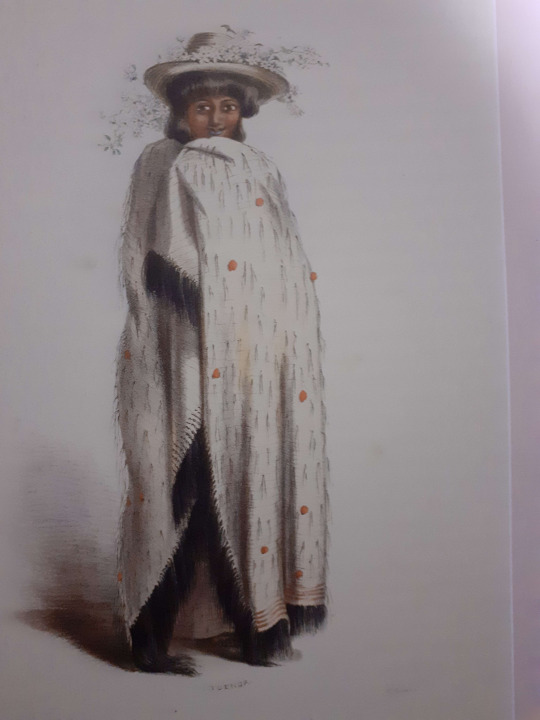
This depicts Toenga (taw-enga) of Ngāti Maru (ngaah-tee Maroo) in a quite fashionable hat. I quite like it, and adapted it (though replaced its flowers with pohutukawas) for Tangata Whenua. I also enjoy the energy Toenga appears to give off- it feels very suitable for Tangata Whenua's personality. However, her primary personality influence is...
Rangi Topeora (Rangi Taw-peh-awhra) of Ngāti Toa (taw-uh) and Ngāti Raukawa (roe-kawa) was a female chief of Ngāti Toa (or so my research seems to imply- sources are frustratingly vague on this) and composer. While there is little information on her- I can find nothing on her birth date, and the range given for death dates is nearly a decade wide- what there is sparks much joy. In Dressed, her relationship with European trader Mayhew (one of many she took) is the main focus where she is mentioned. She admits to being a woman "notorious for following her 'hearts desires'", and I believe that if I had to summarise Tangata Whenua into one short phrase, this is what I would use. Māra is a woman of emotion and desire- that is what motivates her above all else. Another move of hers that I adore is, upon her baptism, Rangi would accept no name except 'te Kuini' (teh koo-ee-nee), which translates to 'the Queen'. She would also at some point adopt the name Wikitōria (wee-kee-taaw-ree-ah), which is the Māori equivalent of Victoria, and one of her husbands was given the name Arapeta (as it looks), which means Albert. She became commonly known as 'the Queen of the South'. Here's a portrait of her from circa 1863, painted by Gottfried Lidauer:
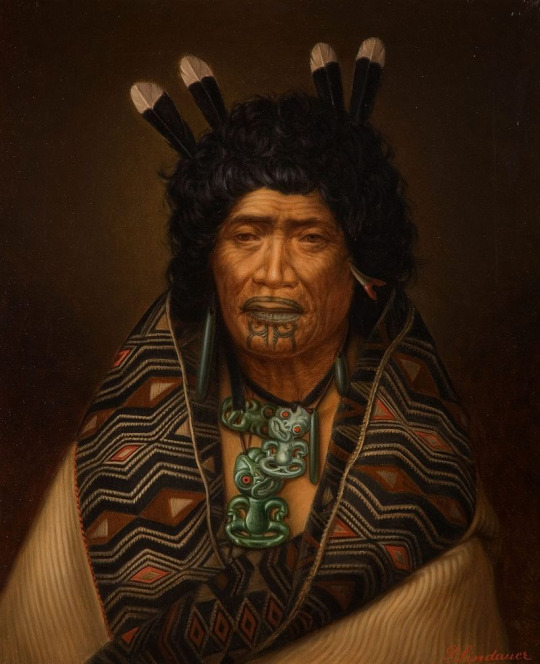
In regards to other notable points of Tangata Whenua visible in this illustration:
I debated with myself over and over again about what I should do regarding her moko kauae (mawkaw k-oh-ay)- the tattoo on her chin, lower lip, and around her upper lip. These are incredibly personal to each individual, and I am no expert in them. Anything I give her will be incorrect, but not giving her anything even more so. Eventually, I settled on referencing a historic tā moko (taah mawkaw- the general name for traditional Māori tattoos)- one which is depicted small and vague enough that surely nothing I interpret from it can be exactly accurate to the original. In that sense, at least, I am hopefully not stealing anyone's identity. If someone happens across this who is more knowledgeable in tā moko than I, I would welcome your opinion on this matter. My intention is absolutely not to appropriate something so personal, but I find myself conflicted on what action to take in this situation. Here is Rakapa Ngawai (rakapa nga-why) with her sons Eru and William, whose moko kauae I have referenced:
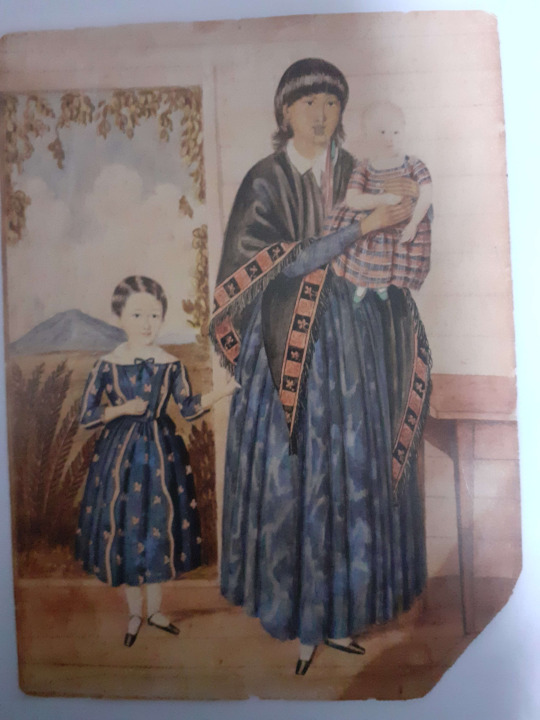
This illustration was made by Joseph Merrett in 1852.
Finally, though it is practically impossible to spot unless you zoom in REAAALLLLY close... I shall mention Tangata Whenua's necklace. It is made of pounamu (poe-nah-moo)- a type of jade only present in New Zealand's South Island, on the west coast. Tradtionally, necklaces (and other jewellery, though necklaces are most commonly known) made of carved pounamu were family heirlooms passed down from generation to generation. They come in a variety of general shapes, each with their own symbolism. For Māra, I've decided on a Hei Matau (hey mah-toe) (fish hook) shaped pounamu necklace. It is said to grant good luck, strength, and safe travel. It also draws from the traditional tale that New Zealand's North Island was a huge fish raised from the ocean when Māui (yes, just like in Moana) caught it on his fish hook- which is said to be made from his grandmother's jawbone. The ocean, in addition, is deeply important in both Māori and pākehā (paah-keh-haah- a word initially intended to denote European New Zealanders by Māori, but which can generally refer to non-Māori New Zealanders) cultural traditions. As such, fish hooks were quite important back in the day, to the point that people would always keep one on their being. Upon European contact, this constant wearing of fish hooks was taken as a sort of ornament- and gradually it evolved to be such. I imagine Tangata Whenua has only gotten her pounamu Hei Matau in recent years upon this illustration, replacing her fish hook tool. When New Zealand reaches adulthood, Tangata Whenua will pass this necklace down to her.
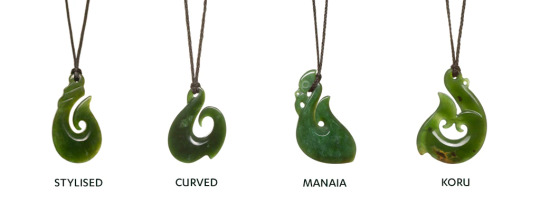
Here are some different styles of pounamu Hei Matau- the latter two incorportating two other styles as well. Tangata Whenua's necklace is most similar to the curved design, though they're not identical.
So that's my long ass explanation finished! If you read this far, reblog/comment with a cookie so I can be surprised people listen to me speak!!
Edit: I forgot to talk about Tangata Whenua's inordinately long hair!!! Here's the gist (from Day 3's post):
In Māori culture, the head (and thus hair) is considered very tapu (sacred). Long hair often indicates high status. In fact, in traditional Māori culture, one's hair may only be attended to by one of more mana (generally refers to reputation/status/legacy- doesn't have a close English concept unfortunately, but for now think of it like rank or status). As the personification of the Māori culture, Tangata Whenua was probably viewed as quite an important atua (god, sometimes translated as spirit), meaning no mortal could have more mana than her. As a result, unless any other atua decide to stop by for a chat, there is no one who can style her hair, or cut it. (I imagine she still brushed it, at least because unkempt hair was a sign of mourning.)
Apologies for any confusion that may have caused!!
#hws new zealand#hws england#hhw day 1#prompt: heirlooms#period typical racism cw#long ass rambles#historical hetalia#hetalia fanart
9 notes
·
View notes
Note
JAMES!!! I dare u to kiss Australia >:Dc *plays romantic jazz music in the background*


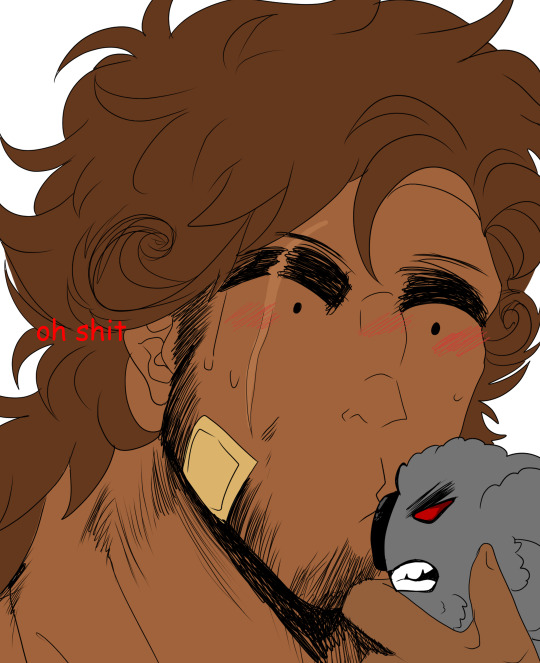
"Yer n' ya shitty as love song ar' gonna 'ave t' pay fer me face reassignment surgery mate."
#asknzmate#aph new zealand#hws new zealand#aph australia#hws australia#aph#ask#new zealand#nz#aotearoa#hetalia#ask blog#anon#nzoz
17 notes
·
View notes
Photo


So...Hi, been a minute since I posted one of these. Not for lack of content to post but just because...I’m lazy.
Here are New Zealand and Australia. Fun story, I’ve had these made for about a month now at this point. Australia is mostly based off of my own headcanons, but New Zealand was based off of @draw-a-circle-thats-the-foxhole‘s headcanons and @stirringwinds drawings of her. I was going to eventually post them, but then draw-a-circle-thats-the-foxhole posted their Artbreeder of them yesterday (which I loved) so now I’m just posting them to show how I had interpreted them. Posting Australia and NZ together because why not.
I do have some actual design details to talk about with these two though. NZ I used Maori portraits and used some women from my own portfolio to make her. Australia has bits of England used to make him as well as other characters. I did use some aboriginal Australians in the making of him, although it doesn’t come across that much.
#hetalia#hws#aph#aph new zealand#hws new zealand#hetalia new zealand#hetalia australia#hws australia#aph australia#i wish I had posted them earlier but i'm LAZYYYY#is this weird for me to post? i think it's only weird because i waited too long and they released their own#oh well this isn't meant as an attack it's just me being awkward#llike my one additional headcanon is that in the modern day NZ is genderfluid#i was quite proud of NZ's hair because it kinda looks like the loopies that origial hetalia flavor NZ has
79 notes
·
View notes
Text
I dont post it in here, but I have a comic that has country personifications too (not hetalia) and I like to follow the hrtalia fandom to get an idea of possible problematic interpretations of country personifications...
1. To make it simple:
A) the majority of USA, Canada, Australia, Nz and European Nations population are white;
B) Historically "first world" (or "priviledge") Nations have WHITE governs who COLONIZE, ENSLAVED, INVADED and killed thousands of ppl, creating a global capitalist system that keeps poor countries in poverty and its DESTROYING the environment making the colapse of human species really close (and this is not an exaggeration, the same WHITE elites that genocide indigenous/ enslaved african ppl/ colonized everyone creating poverty and misery IS the today's billionaries and CEOs destroying the ecosystems)
C) ONLY bc of that 🔼 specif context diaspora happened.
B) In THAT context, "racebending" White historically Nations seemed to DENY the CRIMES commited by that National elite and it makes ALL millions of ppl from actual colonized countries to feel incredibly uncomfortable.
----> A solution to that would be keep those Nations being white, constantly CRITISIZE them and expose their past and create region ocs to represent diaspora or indigenous Nations. Ex: "USA" may be white, but his half sister "Los Angeles" was raised by Spain and have mexica (aztec) origens, Florida has indigenous Seminole origins etc.
~~~~~~~~~~~~~~~~~~~~~~~~~~~~~
2. To me, Tumblr must be populated by liberal 13 years old from USA, bc the amount of "FReE SPeAcH" discourse I see when ppl get critized is unreal... "BuT iS OnLY AnIMe" - like, really? Is like ppl believe their actions have *no consequencies at all*, they can do whatever they want and get away with it bc apparently they had the RIGHT to do so... If you write pedophilic fanfics and bizarre rape fetishes and 1. Refuse to put a proper warning; 2. Refuse to say "Im against it in real life, I only write/draw for X reason"; 3. Its apologetic about it - obviously you're a messed up creep harming ppl [sooo common in hetalia fandom] and if you write racist ocs and attack ppl denuncing it - obviously you have to face the consequences.
RACEBENDING NATIONAL PERSONIFICATIONS: A TREATISE
DISCLAIMERS:
I AM NOT WHITE, I AM A POC. I am not writing this because I’m a butthurt white person who gets pissy when someone makes my white faves nonwhite and thus unrelatable to me for ‘some’ reason.
I AM NOT PERSONALLY ATTACKING ANY INDIVIDUALS WHO RACEBEND OR IMAGINE THEIR NATIONS TO HAVE A DIFFERENT ETHNICITY THAN WHAT THEY DO IN CANON; ON A SIMILAR NOTE, DO NOT ATTACK SUCH INDIVIDUALS FOR ME. This is a discussion of general fandom trends and a larger phenomenon, the issue I am talking about cannot be solved on an individual to individual basis.
I AM NOT TRYING TO STOP FIRST NATIONS PEOPLE FROM RECLAIMING THEIR NATIONS. As I am not First Nations myself, I would not wish to deny what these individuals emotionally and mentally reap from reclaiming their nations.
I AM NOT THE ���POC AREN’T ALLOWED TO HAVE FUN AND SEE THEMSELVES IN THEIR FAVES” POLICE; I AM NOT YOUR MOM, DO WHATEVER YOU WANT. Again, this is a discussion of fandom trends and a larger phenomenon. I think it’s almost always worth examining why we do the things we do and the reasons behind a trend.
I AM NOT AGAINST RACEBENDING IN GENERAL. This is specifically an essay on racebending in nationverse Hetalia and other personified nations fandoms.
PREFACE
As stated before in my disclaimers, this essay is not intended to be a condemnation of individuals who participate in racebending. Rather, I intend to make a macro-critique of wider structures and patterns. For this reason, this essay is not accusing anyone engaging in racebending of holding any specific belief. I cannot stress enough how much I do not know you, the hypothetical reader who engages in racebending.
Again, my intent is to critique wider structures and patterns.
This essay is a conversation I would like to have with other POC and other marginalized groups, especially POC based in white, Western countries. Thus, I ask people not included in the above groups to refrain from weighing in on this.
ALTERNATIVE GOOGLE DOC LINK HERE
TABLE OF CONTENTS
The Difference in Reception for Racebent versus Non-Racebent Characters
The Inherent Politicism of Personifying Nations
The State of POC Representation in Hetalia
The Assumption of Interchangeability in POC Experience
The Myth of Multiculturalism
“It’s Just Fandom, Why Are You Trying to Control POC Who Just Want to Have Fun and Want to Represent Themselves?"
Conclusion
The Difference in Reception for Racebent versus Non-Racebent Characters
I will start this essay off with an acknowledgement of my station in the Hetalia fandom and how it uniquely equips me to talk about this topic – I am very fortunate to enjoy a follower base that primarily follows me for non-Western characters, whether they be canonical or my own original characters. As someone who mostly posts non-Western characters, I can confirm that there is a wider disparity in reception between drawings of my white characters and non-white characters. The following example is not from myself, but from the artist miyuecakes who similarly focuses on predominantly non-white, non-Western countries. You can see there is a drastic gap in the amount of notes that post focused on five nations considered to be non-Western versus a drawing of Female America.

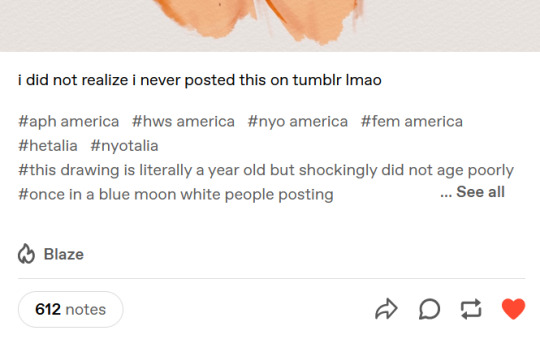
Stating this fact of the fandom is fairly noncontroversial. I would also assert that the following statement is equally true, however given recent reception, is far more controversial: “There are far more instances of racebent canonically white/Western characters, which receive far more traction than their non-racebent counterparts, whether canonical or not.”
I want to make clear what my statement is not saying:
Racebending is only done by white people seeking to score clout and diversity points without having to care about canon non-white characters. In fact, the vast majority of racebending in the fandom is done by POC looking for representation; given the amount of white canon nations compared to any other nation, POC who engage in racebending see it as a way of “evening” the disproportionate overrepresentation of white countries.
POC who engage in racebending are doing so to score clout and diversity points with a white audience. Refer to my above point.
Racebent canonically white characters are met with no controversy or racist/bigoted vitriol. It is fairly well known that there have been multiple harassment campaigns, particularly on Twitter, against artists and editors who’ve engaged in racebending even outside of the Hetalia fandom: see the Black Anya edit, Thumin’s artwork and resulting hate. POC being visibly POC in online spaces will always garner backlash.
On a similar note, I am not including POC cosplayers cosplaying white or light-skinned characters in my definition of racebending. Being angered by POC who cosplay characters of a different complexion is blatantly racist; anyone who is angered by this has nothing of value to add and not worth arguing with.
I am a bitter artist who is mad that I don’t receive enough notes on my posts with non-racebent characters compared to posts about racebent white characters. As stated earlier, I am grateful for the audience I’ve cultivated who specifically follow me for non-racebent non-Western content; I am also more than aware that my content is not what people who seek out racebent content are looking for, and have no interest in changing either my content or their tastes. The last thing I would wish to do is to label POC creators who engage in racebending as “the enemy” and POC creators who don’t as “my side.”
With that out of the way, I bring up this observation because I think it’s worth asking ourselves, POC specifically, the following questions: Why? Why is there this discrepancy in frequency and reception between these kinds of characters and content? Why do people racebend in lieu of focusing on existing POC and creating their own non-white characters?
The easy answer most would give is because white characters are over-represented and given more screen time and attention in the canon, so people, especially POC, will become attached to them and create variations of them that hit closer to home for them; this is especially the case if you are a POC who has had experiences living as a minority in a Western country. Some POC may also use racebending as a way to subvert national myths that have historically excluded people of color for a variety of racist, imperialist reasons. I know I used to subscribe towards a depiction of non-white passing America and Canada for this very reason.
In the rest of this essay I would like to examine and critique the practice of racebending national anthropomorphisms traditionally and typically depicted as white in the context of Hetalia and by extension other media involving similar premises. This essay argues that while racebending may be harmless for most other anime, Hetalia – by virtue of its content centering real life nations – carries political implications that are not necessarily appropriate.
I stress again that I can’t stop you or what anybody in the Hetalia fandom does. I do not have that kind of power nor the will to do such a thing. All I ask is for you to listen to the following with an open mind, and if there’s only one thing you take away from this, I hope it’s to realize that POC in particular have valid reasons to dislike racebent depictions of white nations; holding such a stance does not make them anti-POC representation and somehow no longer POC and instead, a member of the white oppressor class.
The Inherent Politicism of Personifying Nations
Firstly, I repeat that a series about personified nations is deeply political and every creative choice carries political and socio-cultural ramifications, whether intentional or not and made by the creator or the fan. Even if you mostly interact with Hetalia in a depoliticized context, others may not, and given that nationverse Hetalia is about personified nations, this is perfectly reasonable.
Let us look into the canon material of Hetalia- It is shown that nations on average have close ties to their governments, viewing them as their bosses and carrying out actions for them. We are shown that there are nations who go against the orders of their governments, such as Germany; this does not mean all nations follow in that pattern, however, and there are many who are in lockstep with their governments and their actions.
Therefore, for individuals whose ethnic groups and nations have suffered great harm from oppressor nation-states (Philippines v. United States, Indonesia v. Netherlands, India v. England), it is not irrational for them to be unsettled by their oppressor being racebent- especially when said oppressor nation-state is depicted as being the same ethnicity as the very group(s) they marginalized. This is uncomfortable for multiple reasons:
There is an implication that a member of a marginalized group possibly chose to take part in atrocities and misdeeds that the said marginalized group historically not the major perpetrator behind. In more egregious cases, a member of a marginalized group willingly chose to commit atrocities and misdeeds on a large scale against their own group.
The oppressor state personification was forced by their government to commit these grievous acts of harm against members of other marginalized groups/their own marginalized groups; thus, the personification of the nation-state, the people, has little to no culpability as an oppressor, and is instead made into a fellow victim of their own government.
This deflects blame from the embodiment of the state of being an oppressor. The suggestion here is that the state is somehow completely separate yet intertwined with the government – it was simply the government who perpetrated the crimes… the people were just unwillingly complicit. This can come across as an erasure/rosewashing of the very purposeful policies used to harm and disadvantage colonized/oppressed groups.
This can also erase the fact that in many cases, the people gave the government’s actions their tacit approval whether it was through whole-hearted enthusiasm or apathy towards the suffering of others.
In the case that the racebent nation’s minority ethnicity was historically involved in such acts, this involves highly sensitive conversations about minorities’ complicity in crimes and assimilation into the white/majority order (e.g. Chinese and East Asian settlers in Hawaii after America’s illegal annexation, Korean collaborators with the Japanese annexation of Korea, African American soldiers in the Philippines); these are extremely touchy subjects that should be had within the relevant ethnic groups, and should not be appropriated by outsiders, particularly white people, especially for fandom purposes.
(I will discuss insiders racebending nation-states to their ethnic group that have suffered mistreatment and oppressed by said nation-states in “The Myth of Multiculturalism.”)
Additionally, racebending may end up justifying those very same crimes, especially in the case of settler colonialism. For example, during French rule of Algeria, the French government began a program of confiscating Algerian land from indigenous Algerians and giving them to French and European settlers. Over the course of two centuries, more and more land was taken away from indigenous Algerians, forcing them to move to the margins of society, where they were barred from accessing employment, higher education, and the other societal amenities.
Many would be able to identify how personifying Algeria as a white, French individual would be erasing indigenous Algerians and implying that the French settlers represent all of Algeria. However, conversely, making France an Algerian man is also playing into colonial French propaganda. The French viewed Algeria as part of France and the French homeland itself, unique even among other French African colonies, and made plans to make Algeria a full-fledged French province, or department. To make the national personification of France Algerian then, is to suggest that this belief was and is correct, that the Algerians are a part of the colonial core of France, even if the intention is to represent the modern day Algerian diaspora in France.
IMPORTANT: I will expand on the politics of representing diaspora populations in the section “The Myth of Multiculturalism.”
Given all of these reasons for why POC may justifiably react negatively to a racebent white nation personification, some may argue against these with:
“Why is it that when the nation is white, they never have to deal with any of these heavy discussions of imperialism, bigotry, oppression, etc, but when they’re racebent they suddenly have to? Why are they suddenly politicized when they’re racebent?”
My response to that is that they were politicized, even when they were white because the act of personifying a nation is inherently political; to ignore a white nation’s history of oppression is a politically charged move in of itself. Are we really depoliticizing POC when we racebend a white nation and try to maintain that same ‘depoliticization’ and omission of historical oppression but this time for a POC face? To racebend a white nation is to refuse to contend with the contradiction of transforming an oppressor class to the very group they marginalize - making racebending an inherently political act. It is not necessarily that whiteness is unpolitical but rather that an active refusal to deal with this contradiction makes the political implications much more obvious.
Additionally, this rebuttal raises another question- Were we to completely forget about a character’s background as the personification of an oppressor state and the political weight of that, would that truly solve the problem of POC being politicized? I don’t think so- In the current world we live in, POC are always political. But exclusively racebending oppressor states makes no attempt to depoliticize non-Western POC states, creating a divide between POC that get to be “depoliticized” and POC who don’t based on their proximity to the West.
The State of POC Representation in Hetalia
Some would argue with the points of my last paragraph saying that I am not including POC who both engage in racebending but also create non-Western POC OCs; if equal attention is given to both, there would be no division between racebent Western POC who get to be humanized and non-Western POC who don’t, right?
To answer this we must acknowledge wider trends in racebending in Hetalia. Consider the following: When somebody has a North African! Romano, how many other North African nations (canon or non-canon) do they show appreciation for? Create content for? Expound the same amount of mental and creative energy for? Furthermore: If they do have another North African nation(s) they create content for, are they allowed to exist as their own separate beings, and not purely exist to be North African! Romano’s tie to North Africa?
Chances are, Romano is reduced to being the token brown character in a largely white cast and isn’t allowed to ever exist without whiteness surrounding him. This is a very diaspora experience, but I find it unfortunate that in a piece of media that enables us to explore any number of cultures and experiences over all of time and history, we (and I’m including myself as another POC who grew up in a primarily white environment) are unable to imagine ourselves outside of this setting and celebrate ourselves without having to exist against a white mainstream. Stories about white engulfment are allowed to exist and should be told, but why is this so common? Why do these stories disproportionately outnumber POC stories where whiteness is minute or absent?
As my audience is intended to be mostly POC, I will not elaborate on the following scenario too much, but I will ask us to scrutinize the ethics of it. What about cases where white individuals racebend some of their white favorite characters and position them as POC representation in lieu of actually focusing on POC, non-Western nations, canon or not? Does this not have implications about what kinds of POC and diversity are considered more palatable and appealing?
Furthermore, when another North African nation does exist alongside racebent Romano, their character and depiction is almost always heavily dependent on their relationship to Romano, a Western nation. This still perpetuates the same inequality I was talking about earlier where POC nations are humanized based on their proximity to the West, whether because they personify a Western nation or happen to have a relationship with a Western nation.
We should not just be talking about having “more” non-white representation, but also the quality of it. It is completely understandable why some POC may not be satisfied with the representation most racebent content provides, even beyond the reasons outlined previously; this type of representation excludes POC who do not have a relationship to the West, and is still largely focused on the West.
IMPORTANT: I am not saying that contact with or influence from the West makes POC somehow “less POC” or that stories from Western-based diaspora are a “diluted” form of representation. I will expand on this in the section “The Myth of Multiculturalism.”
“Well if it’s not good enough for those POC, then they should just mind their business and make their own representation! There’s plenty of non-racebent content out there!”
Many POC do exactly that- creating their own representation without racebending. However, as established earlier, racebent white characters receive far more attention and feedback compared to canonical non-white characters, despite the fact that both depictions fulfill the purpose of “representation.” This can be especially disheartening in a fandom that already heavily tokenizes canon POC nations, whether it’s India being presented as the “nanny”/surrogate parent in Commonwealth group art or Seychelles as the “adopted child of color” in FACES family. To POC content creators, it feels insulting that the wider fandom, rather than developing POC canon characters (or taking advantage of the source material’s potential by making OCs) and viewing them as representation, the fandom chooses to racebend Western nations and celebrates them instead.
I want to make clear again what I am not saying with that statement:
POC who engage in racebending are doing so to score clout and diversity points with a white audience. Again, it’s a fact that the vast majority of racebending is done by POC looking to create their own representation.
POC who engage in racebending should all go stan Seychelles and Cuba instead. This is an extremely individualist solution to what is a wider phenomenon. I do not blame POC based in Western countries for feeling disconnected to the few POC nations we have in canon.
Racebent POC content is more popular than content of non-racebent white characters.
What I am describing here is how an audience (the Hetalia fandom) receives two creations, both made by POC in the pursuit of creating more representation, and the difference in reception. The difference, it seems, is that the wider fandom deems certain kinds of POC representation more appealing, and thus, certain kinds of POC worth focusing on.
The Assumption of Interchangeability in POC Experience
Earlier, I mentioned that one of the possible reasons for POC to engage in racebending is the desire to see an iteration of their favorite character that is closer to their own reality and lived experience. Therefore, some may choose to racebend a white character to embody a marginalized minority in the country instead so they can share more experiences with the formerly white characters.
Here, I will not be dealing with the practice of POC racebending their own country to their own ethnicity, which is the focus of the next section. Instead, I will be delving into the practice of POC racebending another nation to embody a minority (one which they do not belong to) for the purposes of ‘putting themselves in their interpretations.’ I argue that to do this requires assuming a certain level of interchangeability between POC experiences.
First and foremost, POC are not a monolith- we lead drastically different lives depending on our ethnic backgrounds, where we live, our socioeconomic class, our political and racial context, and etc. Therefore, we cannot presume that our experiences of marginalization mean we’ll always succeed in properly representing other minority groups elsewhere; in fact, the goal of projecting our own life experiences onto them means that there will be an obstacle to properly representing these minority groups.
Take the following example: Imagine a Chinese-Malaysian individual greatly enjoys the character of Spain. Wishing to better relate to him, the individual racebends him to be also Chinese. However, a great deal of historical, cultural determinants and nuances separate the experiences of Chinese people in Spain and Chinese people in Malaysia. There are similarities, yes, but this Chinese Malaysian cannot hope to properly represent the Chinese population in Spain if their primary goal remains self-projection. Now imagine that our Chinese-Malaysian individual wished to racebend England to be Indian; an even wider gap separates the experiences and history of Chinese people in Malaysia and Indian people in England, making it even less likely that our individual will succeed in representing the experiences of Indian people in England.
Another point to consider is that attempts at racebending certain national personifications to represent minorities in the country end up erasing representation for the majority population of the country. For example, there has been a historical Japanese community in Peru that dates back to the 1800s and made a large impact on Peruvian culture. However, it would still be inappropriate to make a Peru OC that is mostly Japanese in race, because besides just being not representative of the 99.9% of non-Japanese Peruvians, it would also be taking representation from Peruvian mestizo and indigenous peoples, who make up over 80% of Peru’s population.
This isn’t even taking into consideration cases where nations are racebent to personify ethnic groups that do not have a numerically significant or historically significant population.
“So what if it’s inaccurate? I just want to self-project onto my favorite character!”
If that’s your response, then I encourage you to read the section “It’s Just Fandom, Why Are You Trying to Control POC Who Just Want to Have Fun and Want to Represent Themselves?” where I address assertions of "fandom is not activism" and similar points.
For now, I will ask you to consider the feelings of those very minorities you are ostensibly representing, even if your primary intention is to project your own experiences onto a character. Chances are, they also suffer from little to no representation that depicts them in inaccurate and unflattering ways.
Hetalia is a media property supposedly centered around exploring and learning about other cultures, but so often fails to accurately and sensitively depict many cultures and nations. Should we not show them the grace that canon Hetalia fails to provide?
The Myth of Multiculturalism
Multiculturalism is typically defined as a celebration of a nation’s ethnic diversity. This is generally considered to be a good and progressive value to have, but a closer and more critical look at multiculturalism in practice suggests that not even a value directed at xenophobia is immune to in-group out-group biases. When enacted by the state, multiculturalism is less an acceptance of diversity as it currently exists (especially in regards to non-indigenous ethnicities) and more an assimilation of these “foreign cultures” into the dominant national one.
For example, Singapore has built much of its national identity as a “multicultural” society. This is shown through government policies in language and education, where the languages of the 3 ethnic groups (Chinese, Tamil Indians, Malays) are all officialized and the government promotes education for ethnic minorities in their mother tongues. However, the label of “multicultural” hides the reality of power inequality between the various ethnic groups. Minorities face pressure to display literacy in the language and culture of the Chinese majority for greater societal acceptance and inclusion. In fact, the assertion that Singapore is a multicultural society that treats its ethnic groups all equally, is often used as a cudgel to shut down any allegations that Singapore fails to live up to this national identity. As my audience is intended to be predominantly POC, especially those living as minorities in Western nations, members of my audience are of course familiar with insistences of “But Canada/United States/etc is a melting pot society! Racism isn’t a serious issue, POC can’t be treated poorly in those countries.”
By racebending a national personification to be part of a marginalized population, this is making a political statement by asserting that the marginalized population is in fact a part of that nation, and has always been, despite historical exclusion. The act of racebending is an overly idealistic and uncritical agreement with multiculturalism, without considering how the value actually applies in practice. It rosewashes the reality and existence of cultural imperialism enacted on immigrant/outsider groups.
Racebending can therefore accidentally act as multicultural propaganda, especially when the invokement of multiculturalism is used to stamp out valid critiques of othering and racialization by ethnic minorities. (E.g. “Singapore can’t have problems with racism against Malays! Singapore himself is Malay!”)
IMPORTANT: If you want to argue that nation personifications are not inherently representative of their government, refer to the section, “The Inherent Politicism of Personifying Nations.”
“Well, POC based in Western countries will naturally feel more connected to their Western countries than their homelands, often because of those policies intended to break their connections to their homelands. Why can’t they racebend to reclaim? To feel connected to their Western countries in contrast to their realities of ostracization and othering?”
I have already discussed why other POC (those affected by a white regime’s actions) would be uncomfortable with the implications of tying a POC/marginalized group with said white regime’s misdeeds in the section “The Inherent Politicism of Personifying Nations” so I will not discuss it here beyond mentioning it.
Firstly, I must acknowledge that this argument is fundamentally an emotional one. I do not want to deny what POC in Western countries emotionally derive from racebending the nation-state, even as a fellow POC based in a Western country. Instead, I will approach this argument from another angle.
I ask the following: When trying to represent our experiences as diaspora and minorities, why is personifying a diaspora/minority community not a popular option? The act of choosing to personify a community is inherently political, and we can use it to empower ourselves as diaspora or minorities. For example, by personifying diaspora communities, we can acknowledge that diaspora experiences are different enough from those in the ‘homeland’ to warrant another personification, and also avoid accidentally justifying colonial possession of those ‘homeland’ states.
Additionally, by personifying diaspora/minority communities, we can 1) better reflect our unique day-to-day experiences of being racialized and separated from the mainstream, 2) avoid many of the earlier uncomfortable implications of minority collaboration in majority perpetrated acts and condoning colonialism, and 3) stress our independence and autonomy despite the efforts of the state and majority population to take that away.
To put it another way, why are there so many stories of minorities striving towards being included, or from another angle, subsumed, into the white nation-state despite its frequent rejection of them? Again, what does it say that these narratives of “inclusion into a historically white nation-state” disproportionately outnumber POC narratives where whiteness is minute or absent?
IMPORTANT: I am not singling you, the hypothetical POC diaspora individual who engages in racebending, out. I am asking about wider patterns of representation in media.
“But by personifying diaspora and minority communities separately from the personification of the nation-state, isn’t that basically saying that minorities will never be seen as part of the nation-state? That we will never be included when people think of our nation state?”
I believe this response takes too narrow a perspective on what multiculturalism is and “being part of a nation-state means,” and thus views having separate personifications as ‘justifying’ or ‘promoting’ our exclusion from the nation-state when it may not be the case.
Look at it from this way- Is it not also problematic to have only one avatar for, say, America, and thus imply that there is one true way of being “American?” Having multiple American personifications, in contrast, is a more true depiction of the realities of being American, and more true to the values of multiculturalism; it instead suggests that there are many ways to be American, that we don’t have to be subsumed into the mainstream to be considered “American.”
“Isn’t that functionally the same as different interpretations of the same nation-state coexisting? Why can’t fans just all have a different Alfred/America specific to their own experience who are all equally considered American?”
Once more: I am not trying to stop anyone from doing anything. That’s not within my power to do so. I agree with this statement that largely, having multiple American personifications and multiple America/Alfred fulfills the same purpose of showing that to be American means something different to everyone. However, the reason I advocated for the former approach is because it achieves the same goal with a lot less uncomfortable questions and unique benefits (minority autonomy), as detailed above.
“It’s Just Fandom, Why Are You Trying to Control POC Who Just Want to Have Fun and Want to Represent Themselves?”
First off, I am presenting this essay as a conversation with other POC because I want to make it explicitly known that my position here is not that of a white person seeking to silence POC and lecture them about what is and is not good for them. Secondly, it's because I want to talk about racebending as it currently exists in the Hetalia fandom, something mostly done by POC who wish to represent themselves and create the diversity missing in the source material. I believe pointing out that white people who are uncomfortable with POC characters or only racebend for self-centered reasons likely have a racial bias is obvious, especially to other POC, and wish to progress the conversation beyond this. This is why my discussion on racebending is moving beyond white bias.
As part of centering this as a discussion among POC, I am also assuming good faith from my interlocutors, that their desires for representation and diversity are sincere, and that I don’t look down on them. I hope then, that this assumption of good faith can be afforded to me as well- that my interlocutors believe me when I say that the last thing I want to do is control POC, as a fellow POC.
Having gotten all of that out of the way, let's address some rebuttals to the arguments I've made thus far.
"Who are you to decide what kind of representation resonates with POC?"
You're right. I can't decide what kind of representation resonates with POC. Again, I am not intent on controlling POC, and again, I recognize that many of the arguments in favor of racebending white nations come from an emotional place; I can’t control how POC feel, even if I wanted to do that.
However, it's precisely because of this that I've made my arguments based on factors other than emotional ones, such as the political implications and questioning the inclusivity racebending provides us with. POC joy and happiness is crucial in the face of a system that seeks to crush and suppress us. But from one POC to another, it's not much of a discussion if your response to my points is simply, "Well, it makes me feel represented and happy, and that's what matters most." If we argued based on that, we could go all day. Am I not a POC myself? Do the feelings and happiness of POC who are uncomfortable with racebending not matter? For that matter, who are you to tell the people whose families and people have been historically affected by white imperialist states to stop disliking racebent versions of those imperialist states?
For white people, it is easy for them to shut down racebending, because they don't understand the experience of never seeing yourself in any form of media. I have asked white/non-marginalized people to refrain from this discussion for that very reason. But in exchange for that, we should be able to discuss the ramifications of racebending national personifications, and look deeper at the arguments for and against racebending.
"You're taking this too seriously. People giving more attention to racebent versions of Western countries versus non-racebent POC countries doesn't say anything deeper about someone's political beliefs. People just like the silly anime about personified countries, and that silly anime happens to give more attention to the canonically white countries."
To a certain extent, I get this rebuttal. We cannot solve racism or the privileging of the global north by reblogging Hetalia fanart of Seychelles and Cameroon. Everything I have described here is symptomatic of much, much larger issues that affect billions. But it's symptomatic: fandom is not immune to the ills of wider society. We do not shed our innate biases and prejudices when we enter supposedly apolitical spaces like fandom. In a series about personified nations, our prejudices and biases are naturally magnified because the source material’s nature is deeply political, dealing with history and personified nations and states.
Again I ask: What does it mean that the POC representation made by POCs is so often limited to racebending canonically white characters, in the context of the world order we live in where proximity to the West automatically confers certain privileges?
IMPORTANT: Refer to the section “The Myth of Multiculturalism” if you respond to this with “Are you saying depictions of Western-influenced POC experiences are a lesser form of representation?”
If that fails to convince you, and you still believe the inequality in reception between racebent and non-racebent nations doesn’t say anything deeper, I respond with the following- Isn’t it still worth it to try and show the same support and energy to the non-racebent, non-Western countries and their creators, regardless of whether that content speaks to you or not?
One last time, I’ll clarify what I’m not saying with that:
Stop liking America and Russia and England. I repeat, I cannot control what POC like or feel or do, and I repeat, what characters you personally like is a very individualistic view on a wider, systemic issue.
In the section “The State of POC Representation in Hetalia,” I discussed how disproportionately giving to racebent countries versus non-racebent non-Western countries is not an intersectional form of POC representation, and fails to address the underrepresentation of non-Western countries and cultures given the global colonial hierarchy. My above statement is therefore saying that if we POC want to achieve a more intersectional form of solidarity and representation, to create a fandom that’s more non-Western friendly, to generally support all types of POC creators, we should not neglect certain kinds of POC content just because it doesn’t personally resonate with us.
You don’t have to. Fandom is not activism. For many, fandom is an escape from the grim realities of the outside world. But in a media property all about exploring other countries’ cultures and histories, can we not strive for the spirit of the source material, and be a little more open-minded in exploring other countries and other forms of POC representation? Even in this miniscule way?
CONCLUSION
I would like to conclude this essay on the matter of irithnova, and the recent controversy she’s been embroiled in for stating many of the points I have made. Yes, our tones were different. But no amount of harsh tone warrants the outrage and rather racist backlash her post received. irithnova has been one of the most active voices in the Hetalia fandom speaking out against racism, from the exclusion of POC in j-ellyfish’s character polls to myrddin’s behavior. However, as soon as she, a Filipino, expresses personal discomfort with certain depictions of a nation that’s caused great harm to her people, other POC were the first to get mad at her for seeing the political implications of a POC personified America, to the point of trying to deny her reality as a feminized and racialized member of the diaspora living in a colonial European country and calling her functionally white.


POC solidarity doesn’t mean we have to all agree with each other, or even like every other POC. But I want to note the irony here of people committing the very act they accused irithnova of doing- telling her, a Filipino, that she wasn’t allowed to criticize racebent depictions of America, thereby trying to control POC.
If your response to this is “Well, sure irithnova didn’t deserve the harassment, but she was still wrong to criticize racebending because it wasn’t her place!” I would like to remind you of the following points:
Scroll up to the top and read this essay again. Regardless of tone used, there are valid reasons for POC to dislike and criticize depictions of racebent countries.
irithnova, as a Filipino living in the West and has Filipino relatives in the USA, is intimately aware of the nature of American imperialism and racism against POC. The United States promised to help the Philippines achieve independence but instead robbed it of its sovereignty, putting down resistance to its takeover and instituting American rule because they viewed Filipinos as “lesser” and incapable of governing themselves because of their race. If it isn’t irithnova’s place to feel uncomfortable (and thus criticize) racebent America, then whose is it?
Finally, I want to emphasize one more thing- First Nations/Indigenous individuals have a unique relationship to the colonial settler states that occupy their land. Like I’ve said so many times, I cannot tell any POC how to feel or what to do, and even more so in this case because I myself am not First Nations/Indigenous; I’ve only provided arguments about the pitfalls of racebending and the merits of other forms of representation. But just as how I cannot tell you what to feel or do, nobody can stop other POC feeling put off by a racebent America.
At the end of the day, despite the who-knows-how-many paragraphs I’ve spent articulating the reasons against racebending canonically white nations, I cannot stop anyone from racebending nations if they wish to. But I do hope readers come away with a better understanding of the flaws of racebending, and the benefits of looking away from the Western mainstream and looking elsewhere to represent our experiences as diaspora and minorities. If you’re someone who engages in racebending, but still chose to read this 6K word long essay on the Hetalia fandom, I can’t express my gratitude enough for hearing me out. Honestly, anybody who read through this entire post deserves an award- Thanks for reading 💖
275 notes
·
View notes